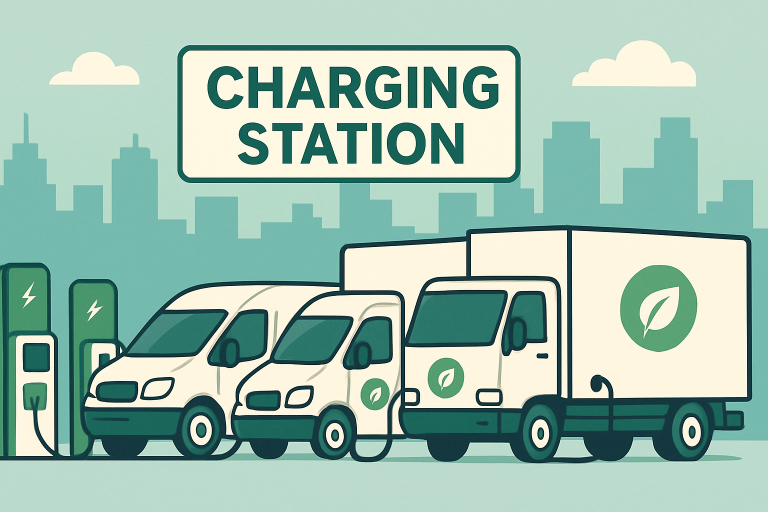Key Takeaways
- Electric vehicle (EV) fleets are emerging as a pivotal solution for advancing sustainable and economically friendly transportation.
- Government support combined with cutting-edge charging infrastructure is making it more practical for businesses to adopt EVs.
- Strategic fleet planning, driver training, and fleet management tools help maximize the benefits of electrification.
- Numerous case studies and research validate electric fleet transitions’ operational and environmental gains.
Electric fleets are emerging as a powerful force in the shift toward cleaner, more efficient transportation systems. Organizations are reducing emissions, reducing operating costs, and supporting ambitious climate goals by replacing traditional gas- or diesel-powered vehicles with battery-powered alternatives. Advances in battery technology, charging infrastructure, and fleet management software are making large-scale electrification more practical than ever. Electric fleets are reshaping how goods and people move from public transit buses to delivery vans and corporate service vehicles. As adoption accelerates, these fleets prove that sustainability and operational efficiency can go hand in hand, paving the way for a greener, smarter transportation future.
Why Companies Are Switching to Electric Fleets
Organizations across sectors embrace electric vehicles (EVs) to future-proof operations, align with evolving sustainability targets, and respond to social and regulatory pressures. With fleets accounting for a significant share of emissions and operating costs, electrification presents a strategic opportunity to reduce environmental impact and streamline expenses. Many leaders in logistics, tech, and even municipal governments are quickly shifting, drawn by the promise of efficiency, enhanced corporate responsibility, and resilience against fuel price fluctuations.
This change isn’t without its challenges, but advances in reliable EV fleet charging solutions are smoothing the transition and making it feasible to maintain daily operations while minimizing downtime. Such solutions help ensure that vehicles remain operational when needed and enable businesses to scale their electrified fleets confidently.
Breaking Down the Cost Benefits
While initial acquisition costs for EVs can be higher than those of traditional fleet vehicles, the operational savings are significant. Electric cars require less routine maintenance—no oil changes and fewer moving parts—and electricity costs are generally lower than fuel prices. Many companies find that lifetime costs for EVs stack up more favorably than combustion vehicles.
Downtime, a critical consideration for fleet managers, is also reduced as electric powertrains experience fewer breakdowns. Coupled with rapidly decreasing battery costs and the growing secondary market for EVs, the financial equation continues to tilt favor electrification.

Environmental Advantages That Cannot Be Ignored
The environmental benefits of going electric extend beyond simple emissions reductions. Electric fleets slash a company’s carbon footprint, decrease urban noise pollution, and contribute to better air quality in cities where transportation is a primary source of pollution. The impact becomes more substantial at scale: as more fleets switch to EVs, the cumulative effect translates to measurable improvements in city air and community health.
Government Initiatives and Incentives
Federal, state, and local government incentives accelerate the transition. These incentives can include significant tax credits, grants for installing charging stations, and reductions in vehicle registration fees. For example, programs featured on the EPA’s Green Vehicles resource provide up-to-date information on available support, helping organizations lower their upfront investment and de-risk the transition to electric.
Building a Robust Charging Infrastructure
A successful EV fleet requires thoughtful integration of charging solutions tailored to business needs. Smart depot charging, workplace installations, and increasingly accessible public chargers work together to ensure operational readiness. Investment in scalable infrastructure is essential, enabling fleets to grow while keeping refueling convenient and efficient. Companies should analyze trip patterns and prioritize future-proofing so the infrastructure evolves with business demands.
Overcoming Common Challenges
Route optimization, strategic vehicle selection, and proactive charging management can alleviate range anxiety. Government support and phased rollout strategies can offset upfront investment. Operational integration can be addressed through staff training, clear communication, and telematics monitoring. Starting small, gradually introducing EVs into pilot routes, and scaling based on data-driven insights, mitigates risk. Building strong partnerships with charging network providers can further streamline the transition, ensuring reliable access to power across operational areas. Regular performance reviews help identify opportunities for improving energy efficiency and vehicle utilization. Renewable energy sources like solar-powered charging stations can enhance sustainability benefits while reducing long-term energy costs. A well-planned and flexible strategy ensures electric fleet adoption delivers both environmental impact and operational resilience.
Key Steps to Launching Your Electric Fleet
- Assess operational needs and incentives: Analyze routes and duty cycles, and review local and federal incentive programs to optimize investment.
- Select appropriate vehicle models: Choose EVs matched to your route profiles, cargo requirements, and terrain challenges.
- Map out charging infrastructure: Decide on depot, in-field, or public charging based on fleet activity patterns.
- Train your team and implement management tools: Prepare drivers and fleet operators for daily EV operations and maintenance, utilizing data analytics solutions for ongoing oversight.
- Monitor and optimize: Track key performance indicators and adjust strategies to maximize efficiency, savings, and sustainability impacts.
Electrification is a strategic transformation, not just a switch in vehicle type. With the right planning, investment in charging solutions, and an incremental rollout strategy, businesses can lead the way to a cleaner, smarter, and more resilient transportation future.
Conclusion
In summary, moving to electric fleets is more than just a technological upgrade; it is a strategic choice that integrates cost savings, environmental care, and operational robustness. Through careful planning and scalable infrastructure development, organizations can navigate early obstacles and gain notable competitive benefits. As advancements in battery technology, expansion of charging networks, and supportive policies progress, adoption barriers will decrease. Companies that adopt electrification now are not only cutting their carbon emissions but also establishing themselves as innovative leaders in a quickly changing transportation sector.

